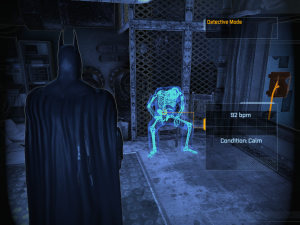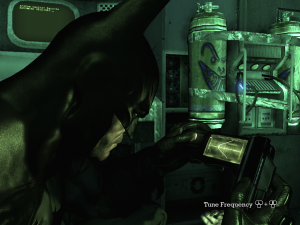Arkham City: Villain Roster
I’m finding it interesting how the villains in Arkham City relate to the ones in Arkham Asylum. To an extent, you have the same gameplay roles filled by different characters, even when the original is still present.
The Joker’s role as the ultimate foe, the one who’s in charge of most of what’s going on and whose voice keeps making announcements over loudspeakers, is taken over by Hugo Strange — but the Joker keeps trying to play that role anyway. He doesn’t have access to the citywide PA system, but he does manage to get your batphone number. He’s on his deathbed, but he keeps making power moves all the same, both against Batman and against the other gangs.
Victor Zsasz was, in the first game, a tutorial on how to use stealth and batarangs: on multiple occasions, he’d take a hostage, and you had to take him down without revealing yourself. There’s a scene like that in Arkham City, but it involves the expert marksman Deadshot, and there’s no hostage — you have to avoid being seen simply because he’s capable of killing you instantly from a distance. (Deadshot wears a leather helmet, jumpsuit, and thin mustache that make him look every bit like an old-timey aviator.) More interestingly, hostage-taking is turned into a general mechanic. In any scene where you’re rescuing people from armed goons, the goons can decide to grab the people you’re rescuing and point a gun at their head, forcing you to sneak up on them. Meanwhile, as I’ve noted in previous posts, Zsasz instead uses the city’s payphones to issue race-against-time challenges, something that wasn’t really a factor in the asylum’s more confined spaces.
Poison Ivy has a stronghold in one corner of the map, overgrown with unnatural vines, but has kept to herself so far and not participated in the plot. Killer Croc makes a cameo, but his main role, as an unbeatable monster that bursts up from the floor, is taken over by a shark owned by the Penguin. (Shouldn’t have left the bat-shark-repellent at home, Bruce.) The Penguin, incidentally, is the only one of the major gang bosses I’ve fought directly. His gameplay role is a new one: the physically unimposing one who’s challenging only because of how he exploits weapons and minions and monsters. He even has Solomon Grundy under his control. Grundy takes the role of Bane: the monstrously huge brawler who can only be beaten with special tactics. Bane, meanwhile, has shifted to quest-giver. He’s still seen exclusively in grotesquely-mesomorphic mode, which makes it a little weird when he just stands there and talks to you.
Of course, Bane does betray you once he’s gotten what he wants from you. The same is true of Mr. Freeze, and almost certainly of the Joker as well (although I haven’t advanced the story that far yet). Mr. Freeze’s boss fight is an interesting one: he’s too formidable to take on directly, but the environment is full of environmental features you can use against him. He learns, though. Most tricks only work on him once. However, he’s easy to lead around: whenever he can’t see you, he follows the heat left by your footsteps, and follows them straight into the next trap you’ve laid for him. It’s a satisfying fight, and I don’t remember anything like it in Asylum, so there is some new stuff here.
The Scarecrow was probably Asylum‘s most memorable villain. Every encounter with him was a bad acid trip. He’s nowhere to be seen in City, but I’ve been through two similar hallucination sequences: one at the hands of the Mad Hatter, one with Ra’s al Ghul. The Hatter is a pretty clear Scarecrow-substitute in character as well as function: both are mind-affecting madmen styled after characters from children’s books. Ra’s and his daughter, on the other hand, don’t have any clear narrative analog in Asylum. Indeed, they basically feel like they stepped in from a completely different story, which is fairly typical for them.
Mainly, though, this game seems to want to just throw as many Batman characters in as it can, like one of those sequences in epic poetry that goes into a long list of the local heroes that were there too. Robin (Tim Drake version) shows up in a cutscene at one point, delivering a new gadget, for no narrative reason other than to let the Robin fans know what his status is in Arkham continuity. Calendar Man is in a cell in the courthouse, delivering stories of his exploits, just to echo The Long Halloween. Sometimes I get the impression that they made all these character models before they finalized the story, and then had to come up with ways to use them.
 Comments(0)
Comments(0)


